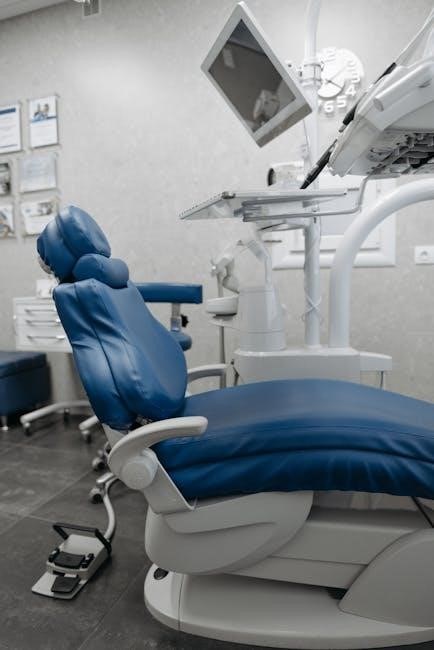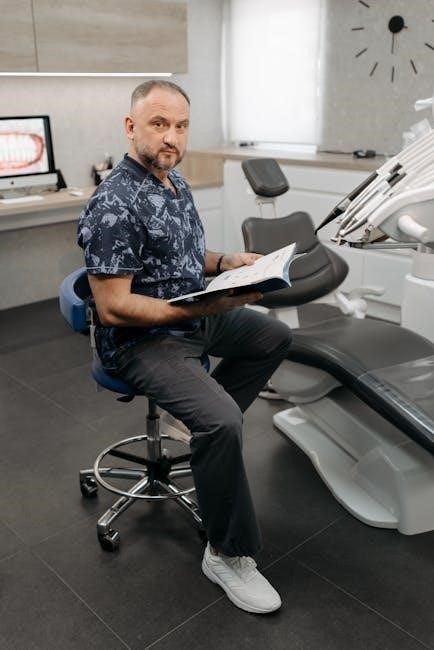Medical coding practice worksheets are essential tools for coders to refine their skills‚ offering realistic scenarios and exercises to enhance accuracy and compliance with coding guidelines. These resources‚ often available as free PDFs‚ provide detailed exercises for diagnosis and procedure coding‚ helping prepare for certification exams and real-world applications.
1.1 What Are Medical Coding Practice Worksheets?
Medical coding practice worksheets are structured resources designed to help coders improve their skills through hands-on exercises; These tools typically include realistic coding scenarios‚ diagnosis and procedure codes‚ and case studies. They are often available in PDF format‚ making them easy to access and print. Worksheets may focus on specific coding systems like ICD-10 or CPT‚ or cover general medical coding concepts. They are ideal for both students and professionals‚ offering a practical way to apply theoretical knowledge to real-world situations. Regular use of these worksheets enhances coding accuracy‚ compliance‚ and preparation for certification exams like the CPC or CIC.
1.2 The Role of Practice Worksheets in Medical Coding Training
Medical coding practice worksheets play a vital role in bridging the gap between theoretical knowledge and practical application. They provide learners with hands-on exercises that simulate real-world coding scenarios‚ allowing them to practice assigning codes for diagnoses and procedures. These worksheets are particularly useful for students and professionals preparing for certification exams‚ as they help build familiarity with coding systems like ICD-10 and CPT. By working through diverse cases‚ coders can enhance their understanding of complex coding rules and guidelines. Regular use of these resources fosters confidence and proficiency‚ making them an indispensable tool in medical coding education and professional development.
1.3 Benefits of Using PDF Worksheets for Coding Practice
PDF worksheets offer numerous advantages for medical coding practice. They are portable‚ allowing learners to practice anytime and anywhere without requiring internet access. PDFs are easily printable‚ making them ideal for hands-on practice. They provide a structured format with clear instructions and answer keys‚ enabling self-assessment. PDF worksheets are also cost-effective‚ often available for free or at a low cost. Additionally‚ they offer a consistent learning experience‚ ensuring that coders can focus on improving their skills without distractions. This makes PDF worksheets a valuable and practical resource for mastering medical coding.

Importance of Practice in Medical Coding
Practice is essential for developing and maintaining accurate‚ efficient‚ and compliant coding skills‚ ensuring proficiency in complex coding systems and adherence to guidelines.
2.1 Enhancing Accuracy in Coding
Regular practice with medical coding worksheets significantly improves coding accuracy by familiarizing coders with complex guidelines and reducing errors; These tools provide real-world scenarios‚ enabling coders to refine their understanding of ICD-10 and CPT codes. By repeatedly assigning codes‚ professionals develop muscle memory‚ ensuring precise code selection. Detailed answer keys offer immediate feedback‚ helping identify and correct mistakes. This iterative process enhances precision‚ ensuring compliance with coding standards and minimizing billing errors. Over time‚ consistent practice builds the skills needed for high accuracy in medical coding.
2.2 Improving Compliance with Coding Guidelines
Medical coding practice worksheets play a crucial role in ensuring adherence to coding guidelines‚ as they provide exercises that test knowledge of ICD-10 and CPT rules. By working through realistic scenarios‚ coders gain a deeper understanding of compliance requirements‚ such as proper code sequencing and accurate documentation. Worksheets often include examples of common coding errors‚ helping professionals identify and avoid non-compliant practices. Regular practice also reinforces the importance of staying updated with guideline changes‚ ensuring codes are assigned in accordance with regulatory standards and reducing the risk of audits or penalties.
2.3 Building Confidence for Certification Exams
Medical coding practice worksheets are essential for building confidence in preparation for certification exams like the CPC or CIC. They provide real-world scenarios that simulate exam conditions‚ helping coders assess their readiness. By solving diverse coding problems‚ professionals identify strengths and areas needing improvement. Detailed answer keys and explanations allow for self-assessment‚ reinforcing correct coding habits. Regular practice with worksheets enhances problem-solving skills and familiarity with coding systems‚ boosting confidence in tackling complex cases. This preparation translates to improved performance during actual exams‚ ensuring coders feel prepared and capable of achieving certification.

Key Features of Effective Medical Coding Practice Worksheets
Effective worksheets include realistic scenarios‚ detailed answers‚ and a focus on ICD-10 and CPT systems‚ ensuring comprehensive practice for coders to master medical coding skills.
3.1 Realistic Coding Scenarios
Effective worksheets incorporate realistic coding scenarios that mimic real-world medical cases‚ helping learners apply codes accurately. These scenarios cover diverse patient conditions‚ procedures‚ and documentation styles‚ enhancing problem-solving skills. By simulating actual coding challenges‚ trainees gain practical experience in selecting the correct ICD-10-CM and CPT codes; Realistic scenarios also improve understanding of coding guidelines and conventions‚ ensuring learners can adapt to various clinical situations. This approach prepares coders for the complexity of real medical records‚ boosting accuracy and confidence in their coding abilities. Regular practice with realistic cases is essential for mastering medical coding skills.
3.2 Detailed Answer Keys and Explanations
Detailed answer keys and explanations are crucial for effective learning in medical coding practice worksheets; These resources provide clear solutions to exercises‚ enabling learners to verify their work and understand correct coding methods. Explanations often include rationales for code selections‚ ensuring a deeper understanding of coding principles. Many worksheets highlight correct codes in bold or color‚ making it easy to identify accurate answers. Additionally‚ explanations address common errors‚ helping learners avoid mistakes in the future. This feature is essential for self-study‚ as it allows learners to independently assess their progress and master coding concepts effectively.
3.4 Focus on ICD-10 and CPT Coding Systems
Medical coding practice worksheets often emphasize the ICD-10 and CPT coding systems‚ which are foundational for accurate billing and documentation. ICD-10 focuses on diagnosis codes‚ requiring precise understanding of detailed classifications‚ while CPT covers procedure codes‚ essential for reporting medical services. Worksheets typically include exercises that integrate both systems‚ simulating real-world scenarios where coders must assign codes for diagnoses and procedures. This dual focus helps learners master the complexities of each system‚ ensuring they can apply codes accurately in various clinical contexts. This integration is vital for developing comprehensive coding skills.

Types of Exercises in Medical Coding Worksheets
Medical coding worksheets include diverse exercises like diagnosis coding‚ procedure coding‚ and combination codes. These exercises improve accuracy‚ compliance‚ and practical application of coding skills effectively.
4.1 Diagnosis Coding Exercises
Diagnosis coding exercises focus on assigning accurate ICD-10 codes for various medical conditions. These exercises typically include scenarios involving common and rare diseases‚ ensuring coders understand code selection rules. They cover acute and chronic conditions‚ injuries‚ and mental health disorders‚ emphasizing proper code sequencing. Exercises also address complex cases requiring secondary or additional codes. Regular practice with these worksheets helps coders master ICD-10 guidelines‚ improving accuracy and compliance. They are essential for preparing coders to handle diverse patient cases effectively‚ ensuring precise billing and data reporting. These exercises are a cornerstone of medical coding training‚ building strong foundational skills for real-world applications.
4.2 Procedure Coding Exercises
Procedure coding exercises focus on assigning accurate CPT codes for medical procedures. These exercises include scenarios involving surgical procedures‚ diagnostic tests‚ and other medical services. They cover various specialties‚ such as surgery‚ radiology‚ and pathology‚ ensuring coders understand procedure coding rules. Exercises emphasize accurate code selection‚ sequencing‚ and the use of modifiers. They also address complex cases‚ such as multiple procedures or bundling issues. Realistic case studies help coders improve their skills in assigning codes for diverse medical scenarios. Regular practice with these exercises enhances coding accuracy‚ efficiency‚ and compliance with CPT guidelines‚ preparing coders for real-world challenges and certification exams.
4.3 Combination Codes for Complex Cases
Combination codes for complex cases challenge coders to assign multiple codes for a single scenario. These exercises involve situations where several procedures or conditions occur together‚ requiring precise code sequencing. Coders must identify when to use combination codes versus separate codes‚ ensuring compliance with guidelines. Practice worksheets include cases like surgeries with multiple procedures or patients with multiple diagnoses. These exercises enhance the ability to handle intricate coding scenarios‚ improving accuracy and reducing errors. Regular practice with combination codes prepares coders for real-world challenges and advanced certification exams‚ where complex cases are often assessed.

Specialized Coding Scenarios
Specialized coding scenarios in worksheets help coders master diverse cases‚ improving accuracy and guideline adherence. These exercises cover inpatient‚ outpatient‚ E/M‚ and age-specific coding‚ enhancing skills for real-world applications and certification exams.
5.1 Inpatient vs. Outpatient Coding Exercises
Inpatient and outpatient coding exercises are designed to help coders understand the differences in documentation and reimbursement for hospital stays versus clinic visits. These worksheets focus on ICD-10-CM and CPT coding distinctions‚ such as inpatient procedure codes (ICD-10-PCS) and outpatient E/M services. Coders practice assigning codes for admissions‚ consultations‚ and follow-ups‚ ensuring accuracy in complex scenarios. These exercises emphasize understanding coding guidelines for acute care versus ambulatory settings‚ preparing coders for real-world challenges and improving their ability to navigate different coding systems effectively.
5.2 Evaluation and Management (E/M) Coding Scenarios
E/M coding exercises focus on assigning accurate codes for patient encounters‚ including office visits‚ hospital consultations‚ and emergency department services. Worksheets provide realistic scenarios that require coders to distinguish between E/M levels based on documentation. Coders practice applying the 1995 and 2021 E/M guidelines‚ focusing on key components like history‚ exam‚ and medical decision-making. These exercises include diverse cases‚ such as new patient visits and follow-ups‚ to enhance understanding of E/M coding nuances. Detailed answer keys and coding tips help improve accuracy and ensure compliance with payer guidelines.
5.3 Pediatric and Geriatric Coding Exercises
Pediatric and geriatric coding exercises are essential for mastering the unique aspects of coding for these populations. These exercises include scenarios involving common pediatric conditions‚ such as vaccinations and developmental disorders‚ as well as geriatric cases focusing on chronic diseases and mobility issues. Worksheets provide coders with realistic patient encounters‚ enhancing their ability to assign accurate codes for these specialized groups. Detailed answer keys offer insights into proper coding techniques‚ ensuring compliance with coding guidelines and improving overall proficiency in pediatric and geriatric coding‚ which are critical for accurate billing and patient care.

Resources for Free Medical Coding Practice Worksheets
Access free medical coding worksheets through professional associations and websites offering downloadable PDFs for ICD-10‚ CPT‚ and specialty-specific coding exercises.
6.1 Websites Offering Free PDF Worksheets
Several websites provide free medical coding practice worksheets in PDF format‚ ideal for self-study and exam preparation. The American Academy of Professional Coders (AAPC) and American Health Information Management Association (AHIMA) offer complimentary resources for members and non-members. Additionally‚ platforms like Coding Clarified and Coder’s Cranium offer downloadable worksheets focused on ICD-10‚ CPT‚ and HCPCS coding systems. These resources often include realistic coding scenarios‚ detailed answer keys‚ and exercises tailored to specific specialties. Practitioners can use these worksheets to enhance their coding accuracy and stay updated with the latest guidelines.
- Websites like AAPC and AHIMA provide free PDF resources.
- Worksheets cover ICD-10‚ CPT‚ and HCPCS coding systems.
- Includes realistic scenarios and detailed explanations.
- Helpful for self-study and exam preparation.
6.2 Professional Associations Providing Practice Materials
Professional associations like the American Academy of Professional Coders (AAPC) and American Health Information Management Association (AHIMA) offer high-quality practice materials for medical coding. These organizations provide PDF worksheets‚ coding exercises‚ and study guides tailored to specific coding systems. The AAPC offers practice exams and coding guidelines‚ while AHIMA focuses on comprehensive resources for ICD-10 and CPT coding. Additionally‚ associations like the American Academy of Family Physicians (AAFP) and National Alliance of Medical Auditing Specialists (NAMAS) provide specialized worksheets for E/M coding and advanced topics.
- AAPC and AHIMA offer coding exercises and study guides.
- Materials focus on ICD-10‚ CPT‚ and E/M coding.
- Specialized resources for advanced coding topics.
- Helpful for both beginners and experienced coders.
6.3 Printable Worksheets for Specific Coding Systems
Printable worksheets tailored to specific coding systems‚ such as ICD-10‚ CPT‚ or HCPCS‚ are essential for focused practice. These worksheets often include scenario-based exercises that mirror real-world coding challenges. For example‚ ICD-10 worksheets might focus on complex diagnoses‚ while CPT worksheets emphasize surgical or procedural coding. Many coding schools and online platforms offer these specialized PDF resources‚ allowing coders to refine their skills in targeted areas. Additionally‚ these worksheets frequently include answer keys and detailed explanations to aid in self-assessment and improvement.
- ICD-10 and CPT-focused worksheets for targeted practice.
- Scenario-based exercises for real-world application.
- Includes answer keys and explanations for self-review.

Using Worksheets for Exam Preparation
Worksheets are invaluable for exam preparation‚ offering realistic coding scenarios and timed exercises. They help identify weak areas‚ improve accuracy‚ and build confidence for certification exams like CPC.
7.1 Preparing for the CPC Exam
Medical coding practice worksheets are essential for CPC exam preparation. They provide realistic coding scenarios‚ helping candidates familiarize themselves with exam formats and question types. PDF worksheets often focus on ICD-10-CM/PCS and CPT coding systems‚ ensuring comprehensive practice. By solving these exercises‚ coders improve their accuracy and understanding of complex coding concepts. The worksheets also highlight high-weightage topics frequently tested on the CPC exam. Detailed answer keys offer explanations for correct and incorrect codes‚ enabling learners to identify gaps in their knowledge and refine their skills effectively. Regular practice with these worksheets builds confidence and readiness for the certification exam.
7.2 Practicing with Timed Exercises
Timed exercises in medical coding practice worksheets simulate real exam conditions‚ helping coders improve speed and accuracy. These exercises are designed to mirror the time constraints of certification exams‚ such as the CPC exam. By practicing under timed conditions‚ coders can enhance their ability to manage time effectively while maintaining precision. PDF worksheets often include a mix of straightforward and complex codes to test proficiency. Regular timed practice reduces exam anxiety and builds confidence‚ allowing coders to focus on high-priority tasks during the actual test. This approach ensures they are well-prepared for the challenges of professional certification.
7.3 Focusing on High-Weightage Topics
Medical coding practice worksheets often emphasize high-weightage topics‚ which are critical for exam success. These topics‚ such as ICD-10-CM codes for common conditions or CPT codes for frequently performed procedures‚ are heavily tested in certification exams. Worksheets targeting these areas help coders master the most impactful coding scenarios. By dedicating practice time to these high-priority subjects‚ coders can significantly improve their accuracy and efficiency. This focused approach ensures they are well-prepared to tackle challenging questions and achieve higher scores on certification exams like the CPC or CCS.

Advanced Coding Practice Topics
Advanced coding topics cover complex scenarios‚ rare conditions‚ and intricate procedures‚ helping coders refine their skills in challenging areas like advanced ICD-10 coding and complex procedure coding.
8.1 Coding for Rare and Unusual Conditions
Coding for rare and unusual conditions requires a deep understanding of medical terminology and coding guidelines. These exercises in worksheets help refine skills in identifying and assigning accurate codes for uncommon diagnoses. They often involve complex scenarios‚ such as genetic disorders or rare diseases‚ which require precise documentation and code selection. By practicing these cases‚ coders improve their ability to navigate ambiguous or less frequently encountered conditions‚ enhancing their problem-solving abilities. These exercises also emphasize the importance of thorough documentation and adherence to coding conventions‚ ensuring compliance and accuracy in real-world applications.
8.2 Advanced ICD-10 Coding Scenarios
Advanced ICD-10 coding scenarios in practice worksheets focus on complex‚ high-acuity cases‚ such as severe injuries‚ multiple comorbidities‚ or rare conditions requiring detailed code sequencing. These exercises challenge coders to apply nuanced knowledge of ICD-10 guidelines‚ including laterality‚ manifestation codes‚ and sequencing rules. Realistic case studies‚ such as polytrauma or chronic disease management‚ are often included to simulate real-world coding challenges. Coders learn to assign multiple codes accurately‚ ensuring compliance with official guidelines. These scenarios are essential for mastering advanced coding concepts and preparing for complex cases in professional settings. They also reinforce the importance of precise documentation and critical thinking.
8.3 Complex Procedure Coding Exercises
Complex procedure coding exercises in worksheets focus on challenging surgical and diagnostic scenarios‚ such as multiple procedures‚ unusual anatomical sites‚ or overlapping codes. These exercises require precise application of CPT and HCPCS guidelines to ensure accurate code selection and sequencing. Coders practice coding for advanced procedures‚ including robotic surgeries‚ endoscopic interventions‚ and complex musculoskeletal repairs. Realistic case studies and detailed answer keys help refine coding skills‚ ensuring compliance with payer guidelines. These exercises are invaluable for mastering intricate coding concepts and enhancing proficiency in procedure-based coding systems.

Group Practice and Collaboration
Group practice and collaboration in medical coding foster teamwork‚ enhancing accuracy and communication. Coders engage in shared exercises‚ peer reviews‚ and coding challenges‚ improving problem-solving skills collectively.
9.1 Team-Based Coding Exercises
Team-based coding exercises in medical coding practice worksheets pdfs are designed to enhance collaborative learning. These exercises provide realistic coding scenarios that require group problem-solving‚ fostering communication and teamwork. By working together‚ coders can identify and correct errors‚ improving accuracy and understanding of complex coding guidelines. Team-based exercises also encourage peer-to-peer learning‚ allowing individuals to gain insights from others’ approaches. This collaborative environment strengthens problem-solving skills and prepares coders for real-world scenarios where teamwork is essential for accurate and efficient coding.
9.2 Peer Review and Feedback Sessions
Peer review and feedback sessions are integral to medical coding practice worksheets‚ fostering a culture of continuous improvement. By evaluating each other’s coding work‚ participants can identify errors and gain insights into different approaches. Immediate feedback helps clarify doubts and reinforces adherence to coding guidelines. This collaborative process enhances understanding and consistency‚ while also building confidence in coding abilities. Regular feedback sessions encourage a growth mindset‚ helping coders refine their skills and stay aligned with industry standards. This interactive learning method is invaluable for professional development in medical coding.
9.3 Coding Challenges and Competitions
Coding challenges and competitions are dynamic tools within medical coding practice worksheets‚ designed to test skills in real-world scenarios. These exercises simulate actual coding environments‚ requiring participants to code accurately and efficiently. Competitions add a competitive edge‚ motivating coders to refine their abilities and achieve precision. Many platforms offer timed challenges‚ case studies‚ or problem-solving tasks‚ fostering adaptability and quick decision-making. Such activities not only enhance coding proficiency but also prepare professionals for high-pressure situations‚ making them invaluable for both learning and professional growth in the field of medical coding.

Continuous Learning and Improvement
Continuous learning and improvement are essential for medical coders. Regular practice with updated worksheets ensures mastery of coding guidelines and adaptability to industry changes.
10.1 Regular Practice Routine
A regular practice routine is crucial for mastering medical coding. Dedicate time daily or weekly to work on practice worksheets‚ focusing on different coding systems like ICD-10 and CPT. Consistency helps build muscle memory and improves accuracy. Start with basic scenarios and gradually move to complex cases. Use PDF worksheets to simulate real-world coding environments‚ ensuring familiarity with diverse medical conditions and procedures; Regular practice also helps stay updated with coding guidelines and industry changes‚ making it easier to adapt to new regulations and standards.
10.2 Tracking Progress and Identifying Weak Areas
Tracking progress is essential to identify weak areas in medical coding. Regularly review completed worksheets to assess accuracy and speed. Use answer keys to understand mistakes and categorize common errors by coding system or topic. Focus on high-error areas‚ such as complex ICD-10 codes or ambiguous CPT guidelines. Set goals for improvement and adjust practice routines accordingly. Consistent self-assessment helps refine skills and builds expertise. By monitoring progress‚ coders can address gaps and reinforce learning‚ ensuring continuous improvement in their coding abilities.
10.3 Staying Updated with Coding Guidelines
Staying updated with coding guidelines is crucial for accurate medical coding. Regularly review official updates from CMS‚ NCHS‚ and AMA for changes in ICD-10 and CPT codes. Subscribe to newsletters and attend webinars to stay informed. Incorporate updated guidelines into practice worksheets to reflect real-world scenarios. Use revised coding manuals and guidelines to ensure compliance. Continuous learning helps adapt to new rules and maintain proficiency. Updated worksheets ensure coders apply the latest standards‚ enhancing their skills and staying current with industry requirements.
